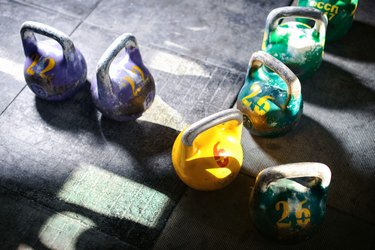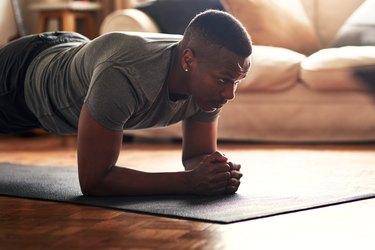
Fat that has made its way around your rib cage or abdomen is common, and is often just referred to as "belly fat."
This type of fat can be tricky to lose, especially because you can't target fat loss to one specific part of your body. That said, it's important to trim down this area, as fat around your middle can increase your risk of diseases like stroke and heart disease, per the American Heart Association.
Video of the Day
Video of the Day
Through exercise, maintaining a calorie deficit (i.e., burning more calories than you eat) and prioritizing other healthy habits, you can lose fat all over your body — including your rib cage — and improve your overall health.
Here, learn how to lose rib cage fat, plus some exercises that target your torso.
Tip
Sometimes certain health conditions can make it harder to lose weight around your rib cage, especially those with belly fat as a common symptom, like hypothyroidism, Cushing's disease and PCOS, per the National Institute of Diabetes and Digestive and Kidney Diseases. Additionally, hormonal shifts from pregnancy, menopause or low testosterone can lead to increased belly fat. Talk to your doctor about your weight-loss goals prior to getting started, especially if you have an underlying health condition. They can help you come up with safe and realistic goals based on your current health.
1. Create a Calorie Deficit
One important component to losing fat is creating a calorie deficit, or burning more calories than you take in. The traditional formula goes: If you restrict your calories by (or burn an additional) 500 per day, you'll lose about 1 pound a week. But this is not necessarily true for everyone (it often largely depends on your genetics, metabolism and overall health), per the Mayo Clinic.
The best way to create a calorie deficit that's right for you is by slowly eating fewer calories per day and exercising more, or a combination of both. Try eating smaller portions and choose low-calorie foods that are also filling (more on that in a minute). You can also use a calorie counter app to track your daily progress.
Tip
Keep in mind, the initial weight you lose while dieting will likely be water weight. This weight drops off more quickly than fat does, per the National Academy of Sports Medicine (NASM). It may take some time for your body to begin burning fat, so try to be patient with yourself!
2. Choose Nutritious Foods
Try to eat more whole foods with a low energy density (i.e., foods that have fewer calories, per the Centers for Disease Control and Prevention). These can include fruits, vegetables, whole grains, leafy greens, lean protein and reduced-fat dairy products.
When trying to lose fat around your ribs, avoid foods high in saturated and trans fats (think: packaged snack foods), sodium and processed sugar, like cupcakes, cookies, crackers and fried foods.
Too much processed sugar, in particular, is associated with larger amounts of fat around the heart and abdomen, which can negatively affect your overall health, per the University of Minnesota School of Public Health.
A great place to start is by swapping out processed snack foods for things with more nutrient content, like fruit instead of dessert foods, crisped veggies (like kale or broccoli chips) instead of regular potato chips and water instead of soda.
3. Stay Hydrated
While bloating is not permanent weight gain, it can feel bothersome and make it harder to track your weight-loss progress.
Bloating tends to happen in your belly and rib cage region, and is often caused by water retention or constipation. One way to fight this is by drinking plenty of water throughout the day, per Northwestern Medicine.
Not only will this help with bloating, but drinking enough water keeps your organs functioning properly and helps keep your stomach fuller for longer, which could help you stick with healthier eating, per Johns Hopkins University.
Aim to get anywhere from 11.5 to 15.5 cups of water per day, through drinking or water-rich foods, per the Mayo Clinic. At the same time, avoid drinking high-calorie, nutrient-poor beverages like soda, sweetened tea, milkshakes and beer.
4. Burn Calories With Aerobic Exercise
Aerobic or cardiovascular exercise can help burn the fat on your rib cage and around your belly. This includes any type of exercise that gets your heart rate up, including:
- Kickboxing
- Step aerobics
- Jumping rope
- Brisk walking or running
- Cycling
- Swimming
- Using the elliptical machine
To lose fat on your rib cage (and all over your body, for that matter), try to get up to 300 minutes of moderate aerobic exercise per week, per the Mayo Clinic.
If you're short on time, try incorporating short, vigorous bursts into your exercise, to make it more high-intensity.
A small July 2021 study in BMJ Open Sport & Exercise Medicine actually found that while both high-intensity intervals and moderate-intensity continuous exercise both helped people lose weight, high-intensity was better at reducing waist and hip circumference in particular.
Try incorporating high-intensity intervals by alternating between a jog and a sprint if you're running, for instance.
5. Incorporate Strength Training
One of the best types of strength training you can do to burn fat (while preserving muscle) is resistance training. With this training, your muscles can continue to burn calories long after you've finished the workout, which will help you burn fat, too (also called the "afterburn effect"), per NASM.
Try to do full-body resistance training at least two days per week, according to the American Heart Association, and incorporate all your major muscle groups, including your arms, legs, abdomen, hips, chest, shoulders and back.
Some common strength exercises that activate the whole body are push-ups, lat pulldowns, bench presses, squats, deadlifts and lunges.
6. Target Your Oblique and Abdominal Muscles
Part of your strength training routine should include abdominal exercises that work many different parts of your abs. Your oblique muscles (on the sides of your torso) are important when it comes to losing rib cage fat because when they're strengthened, your torso will look more toned and defined.
Beyond basic crunches, try some of the following exercises to activate your oblique muscles (where rib fat tends to settle):
- Front planks
- Reverse crunches
- V-ups (which mainly work your rectus abdmoninis at the front of your waistline)
- Side planks
- Torso twists (while lying face-up on a stability ball)
- Wood chops (with a dumbbell, medicine ball or high-pulley cable)
If in doubt, try the following specific exercises to work your obliques:
Single Handle Pushdowns: (Equipment needed: A cable machine and 2 single handles)
- Stand in between the weight stacks on a cable machine
- Have the handles attached to high settings and grab one in each hand, with your feet about shoulder-width apart (your body should be in a "T" shape at this point)
- Push the handles straight down to your sides
- Raise them back up until your arms are parallel to the floor
- Repeat this 10 to 12 times
Ab Wheel Rollouts:
(Equipment needed: An ab roller)
- Kneel on the floor
- Grab the handles of the ab roller and place it on the floor in front of you
- Roll the wheel forward as your extend your arms and lower your chest to the floor
- Stop when your upper body is close to parallel with the floor
- Roll yourself back to the upright position
- Repeat 12 to 15 times
Bicycle Crunches:
(No equipment needed)
- Lay down on the floor or on a yoga mat
- Place your hands on the sides of your head, lift your legs and bend your knees (so your shins are parallel to the floor)
- Move your right elbow and left knee toward each other as you extend your right leg
- Quickly reverse the motion to target your other side
- Repeat 15 to 20 times
Standing Oblique Twists:
(Equipment needed: A medicine ball)
- Stand with your feet about shoulder-width apart
- Hold the medicine ball straight in front of your chest
- Twist your torso to your right (while still holding the ball)
- Reverse the motion and twist to your left side
- Continue back and forth for 15 to 20 repetitions total
Tip
Aim to complete four to five sets of weight training exercises three days a week.
Warning
Talk to your doctor before trying any new exercise program for the first time, or if you haven't worked out in a while, to make sure it's safe and healthy for you to do.
7. Prioritize Other Healthy Habits That Can Help With Weight Loss
Weight loss is about much more than calories in, calories out. Some of the other factors that affect how much weight you lose and how quickly include: genetics, body composition, stress, medications you're taking and your overall health status.
Some of these factors, like your genes, are mostly outside your control. But there are some things you can do to support your weight-loss efforts and your overall health:
- Get enough sleep: Adequate shut-eye (that's seven to nine hours per night for adults) helps your body regulate your metabolism and manage your stress levels. Not getting enough, on the other hand, may drive you to eat more calories and forego exercise because you're tired.
- Manage your stress: Stress often leads to weight gain because it can affect your eating habits, activity levels, sleep and more. Make time each day for stress-relieving activities like exercise, meditation, journaling, listening to music or even snuggling with a favorite pet.
- Talk to your doctor about your medications and health conditions: If weight loss is your goal, have a conversation with your health care provider about how your health status or medications may play a role. They may be able to suggest certain lifestyle or medication changes that could make a difference in your efforts.
The Bottom Line
While you can't target weight loss directly to your rib cage or abdomen, you can take steps to burn total body fat, which will in turn help you trim down and reduce your risk of disease.
Losing weight around your rib cage will involve keeping a calorie deficit, eating nutritious foods and focusing on exercises that burn fat and tone your oblique and abdominal muscles.
By focusing on these steps, you can slim your torso and reap the health benefits of reduced belly fat.
- NIDDK: "Factors Affecting Weight & Health"
- Mayo Clinic: "Counting calories: Get back to weight-loss basics"
- National Academy of Sports Medicine: "How to Lose Water Weight Effectively"
- CDC: "Low-Energy-Dense Foods and Weight Management: Cutting Calories While Controlling Hunger"
- University of Minnesota School of Public Health: "Excess Sugar Linked to Dangerous Heart and Abdominal Fat"
- Johns Hopkins University: "Yes, drinking more water may help you lose weight"
- Northwestern Medicine: "How to Beat the Bloat"
- Mayo Clinic: "Tips for Drinking More Water"
- Mayo Clinic: "How much should the average adult exercise every day?"
- BMJ Open Sport & Exercise Medicine: "Effectiveness of high-intensity interval training for weight loss in adults with obesity: a randomised controlled non-inferiority trial"
- American Heart Association: "What Exercise is Right for Me?"
- American Heart Association: "Too much belly fat, even for people with a healthy BMI, raises heart risks"
- NASM: "Metabolic Conditioning"
- Cleveland Clinic: "Abdominal Muscles"











